
Search Wild Foods Home Garden & Nature's Restaurant Websites:
Beech (American)
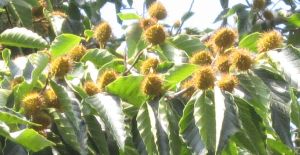
(NOTE: If you are not interested in growing the Beech tree, but just finding the tree and using the nuts, try going to the Nature's Restaurant Online site for the Beech Nuts page.)
American Beech (Fagus grandifolia or Fagus americana) nuts. Some like them, some find them a bit bitter. Don't eat huge quantities of them raw – there is a small amount of a poison called “fagin” in them, though you would have to eat a lot to be affected. Roasted a bit will make them easier to shell. This is a nice snack food, but it would be a lot of work to gather enough for adding to baked goods or similar, but could be done. Usually the squirrels get most of them where I live, and some years the trees produce a good harvest, some years not. They come in an outer husk that has very stiff hairs. The outer husk splits when they are ready to harvest, that has to be removed first, then the leathery shell. I find a large percentage of the Beech nuts are empty.
This is a beautiful tree in all seasons. The problem is, this tree is slow growing, and won't produce a crop of nuts until it is about 40 years old. So if you are planting for harvesting food for yourself, you might as well not waste the space on this one. If you are planting thinking of future generations, I would include at least one of these. With that in mind, this is a good choice if you live where the ground does not get walked on too much, or is away from city pollution - this tree will not tolerate either. The European Beech (Fagus sylvatica) is more tolerant of city conditions and faster growing, but the fruit is not edible unless you soak them in water for a day or two to remove the high tannin content. They don't taste as good either, even if you do process them to get the tannin out.
Soil & Site: They will grow in a wide variety of soil types from wet clay to well drained sand. They require full sun to partial shade. If grown in an open area, the tree will spread out - grow wide and fairly low. If grown in with other trees, it will go up high. So, if you are thinking in terms of someday, someone gathering the nuts, you will need to plant in an open, sunny spot.
Planting: If you were to go to a nursery and ask for a Beech tree, they will show you the European Beech. You are going to have to transplant a very small one under a meter (3 feet) tall, and do it in the fall after the leaves have fallen or turned brown (sometimes the younger ones hold onto their dead, brown leaves in the winter). It could be done in the very early spring as well. To find one for transplanting, you will need to find a woods with them. These grow in deciduous woods in association with Maple, Oak and often in mixed woods with White Pine. It is a fairly common tree in the range the maps show, so you shouldn't have much trouble. One side note, don't bother trying to transplant one that is growing in clay. You will need to find one growing in sandy loam. Be careful when transplanting not to cut many roots - go slowly and work around the tree following roots.
Prepare the spot where you want it by digging out the hole and mixing in leaf compost with the soil before you put it back over the roots of your new tree. Cover the area with at least 5 cm (2 inches) of mulch and water well. For the first year, do not let the soil around it dry out. After that, there is nothing to do, but do be aware that this tree does not like the soil around it walked on or used heavily, so if you have children or animals in the yard, I would suggest putting a fence of some sort around it. The fence should be at least the diameter of the crown of the tree, but when young, I'd double that. Also, don't rake the leaves around it in the fall, and even put an extra couple of inches of leaves around it.
Description:
American Beech (Fagus grandifolia or Fagus americana):- USDA Plant Hardiness Zone: 4-9 (More information on hardiness zones).
- Soil pH: 4.0-7.0 (best range is 5.0-6.5)
- Plant Size: Up to 35 meters (115 feet) high
- Duration: Can live for hundreds of years - a slow growing tree
- Leaf Shape: Elliptic
- Leaf Phyllotaxis (Arrangement) on branch: Alternate
- Leaf Size: Up to 12.5 cm (5 inches) long with short stem
- Leaf Margin: Serrated (saw toothed edge)
- Leaf Notes: Leaf veins terminate at each tooth on the leaf margin.
- Flowers: Male: Yellowish to slightly reddish flowers in spherical clusters on 2.5 cm (1 inch) stem. Female: flowers similar but on shorter stems
- Fruit: Thick outer husk with few, evenly spaced thick, short, stiff, reddish hairs. When fruit is ripe, the outer husk opens like a four petalled flower. Two nuts in leathery husk, triangular, dark brown to tan to reddish brown. Meat is white.
- Bark: Very smooth, silver grey bark even on mature trunks
- Habitat: Well drained, moist soils. Does not do well in polluted areas, or areas with a lot of traffic on ground around tree. Can withstand more shade than most trees - similar to the Sugar Maple in this regard.
Web Resources:
- Recipe search on the web here (Google search) and here (Bing search).
- Pictures on the web here (Google images) and here (Bing images).
- Interactive USDA distribution map and plant profile here.
- The Biota of North America Program (BONAP) distribution map here. BONAP map color key here.
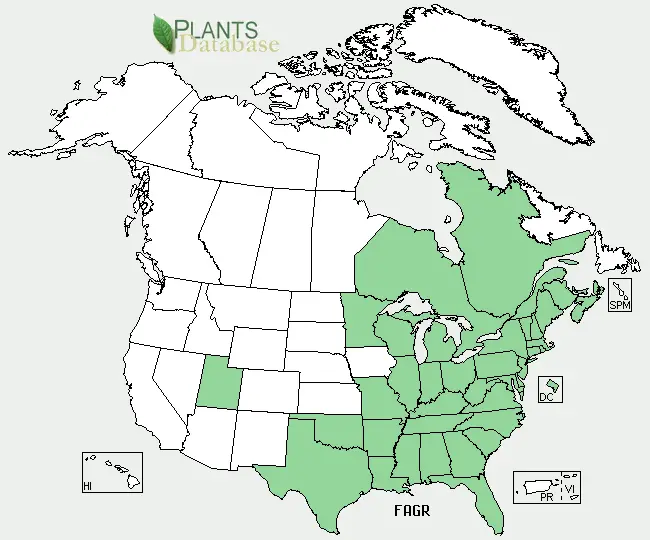
American Beech (Fagus grandifolia or Fagus americana) range. Distribution map courtesy of U. S. Department of Agriculture (USDA Natural Resources Service) and used in accordance with their policies.
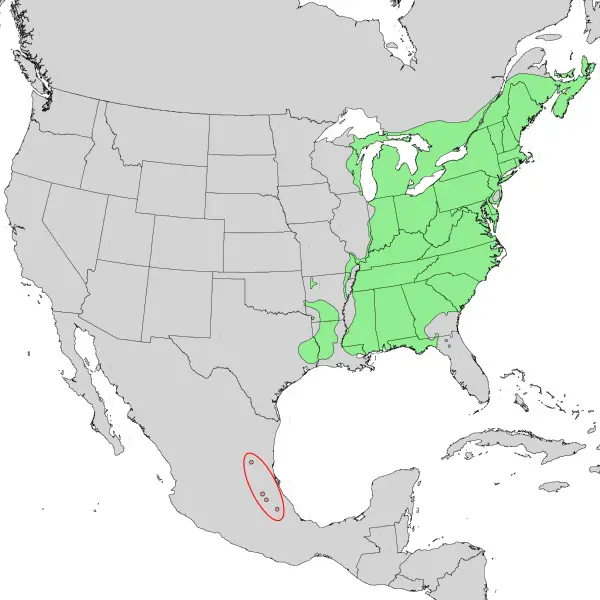
American Beech (Fagus grandifolia or Fagus americana) range. Distribution map courtesy of the USGS Geosciences and Environmental Change Science Center, originally from "Atlas of United States Trees" by Elbert L. Little, Jr. .
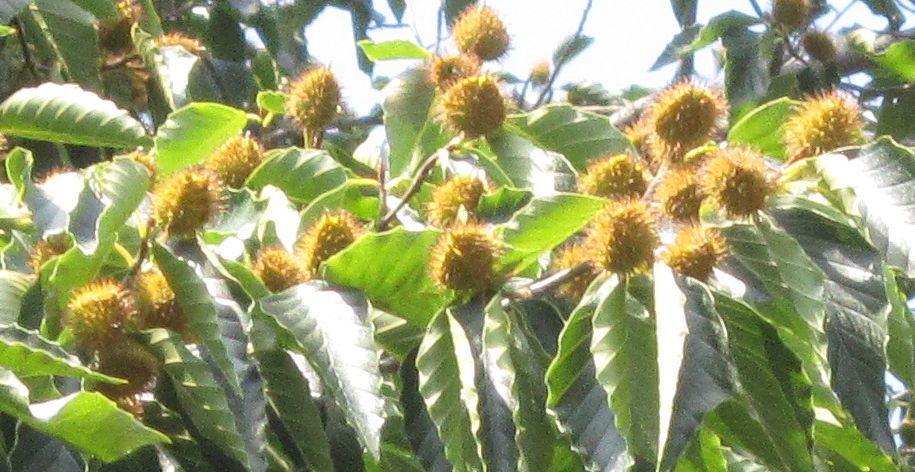
Close up of Beech Nuts almost ripe. Beech tree leaves are beautiful and distinctive.
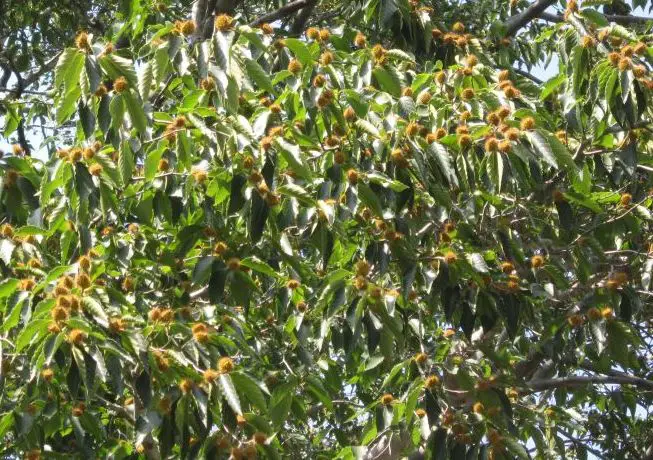
Beech tree laden with Beech Nuts.
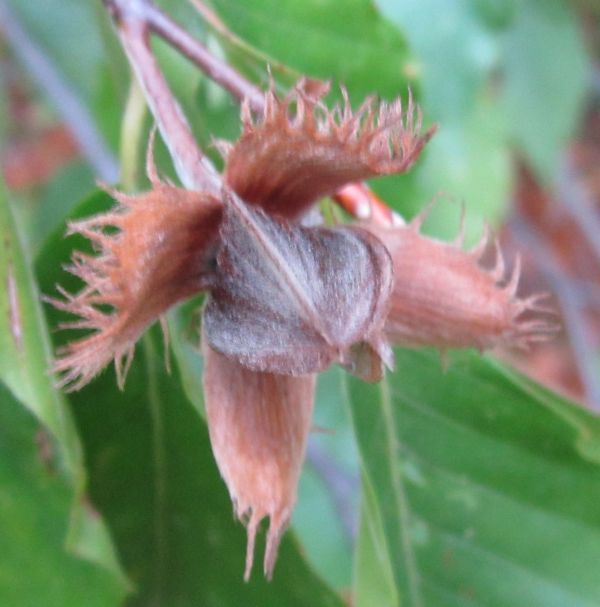
When Beech nuts are ready, the outer husk opens up like a four petal flower, leaving two, three sided nuts ready to be picked.
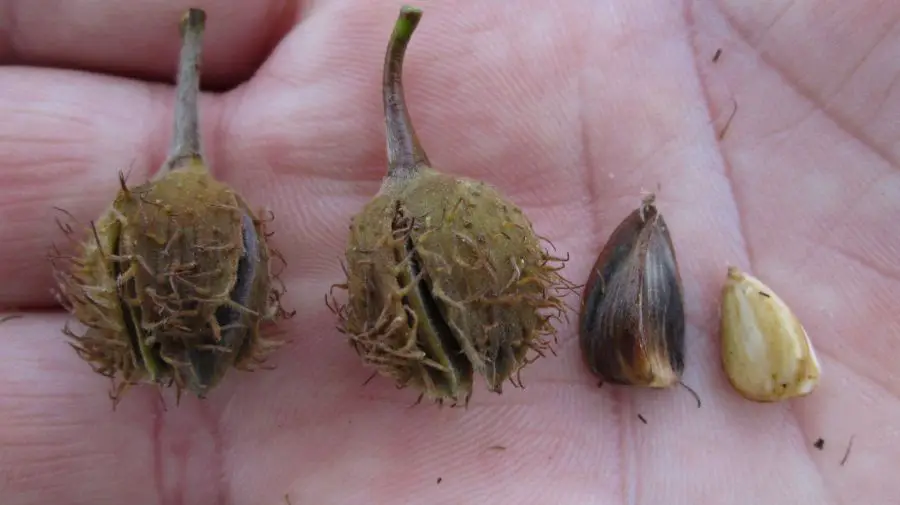
The two on the left are Beech nuts in the husk, the next one to the right is the nut in the leathery shell, the one on the right is the edible nut you eat. Be forewarned, the vast majority of nuts are empty in my experience. You can tell before opening the leathery shell. On the ones that are empty, the three flat sides of the nut are concave - hollowed inward. On the ones that have a nut inside, the three sides are flat and not concave. In the one above in the leathery shell, it had a nut in it.
Search Wild Foods Home Garden & Nature's Restaurant Websites:
Share:
Why does this site have ads?
Originally the content in this site was a book that was sold through Amazon worldwide. However, I wanted the information to available to everyone free of charge, so I made this website. The ads on the site help cover the cost of maintaining the site and keeping it available.
Google + profile
